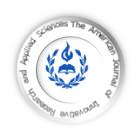
AIMS AND SCOPE
DIFFERENT TYPES OF PLAGIARISM
PLAGIARISM
Indexed by:
| HOME | ABOUT US | ARCHIVE | AIMS AND SCOP | AUTHORS | REVIEW | SUMIBMIT MANUSCRIPT | EDITORIAL BOARED | PUBLICATION FEE |



|

Plagiarism is not acceptable by the AJIRAS journal at submissions or publication. With the submission authors declare the originality of their work, properly citing, reusing or copying previous publications.
The author is requested to make a plagiarizm detection of his paper by using a free soft wore "Viper" or other plagirizm service. If plagiarism is detected during the peer review process, the manuscript may be rejected. If plagiarism is detected after publication, the publisher has the right to issue a correction or retract the paper.
Worl chat, ResearchBib, SIS database, i.f.s.i.j, Scribd, IISJ, Eurasian Scientific Journal Index (ESJI), Indianscience.in, arastirmax, Directory of Research Journals Indexing, Pak Academic Sesearch, AcademicKeays, CiteSeerX, UDL Library, CAS Abstracts, J-Gate, WorldCat, Scirus, IET Inspec Direct, and getCited
PLAGIARIZM ETHIC
Avoid plagia:
To ensure that the work you are submitting is yours and only yours the authors are requested to make a plagiarizm detection, by
using ''Viper" which is a free plagiarism checker software, when they submit their papers for publication to the AJIRAS journal. The
authors can use others plagiarizm detection services.
Text taken directly or closely paraphrased from earlier published work that has not been acknowledged or referenced will be
considered plagiarism. Submitted manuscripts in which such text is identified will be withdrawn from the editorial process. Any
concerns raised about possible plagiarism or other violations of ethical guidelines in an article submitted to or published in AJIRAS
will be investigated fully and dealt with in accordance with the COPE guidelines (See more detail ).


|
American Journal of innovative
Research & Applied Sciences
Research & Applied Sciences
ISSN 2429-5396 (Online)
OCLC Number: 920041286
OCLC Number: 920041286
| HOME || ABOUT US || ARCHIVES || AIMS AND SCOP || AUTHORS || REVIEW|| SUBMIT MANUSCRIPT || EDITORIAL BOARD |

Deliberate plagiarism
This needs little explanation because it is the simple - and totally wrong - act of attempting to pass off someone else's work as your own.
Paraphrasing
A little more strategic, this one - basically, you read a few texts, write down a few key sentences, change the words around, throw in a few quotes and citations to throw your tutor off the scent and 'hey presto' you have the perfect essay, right? Wrong!
Your tutors have read those books and seen this scam before. As with the first example, this type of plagiarism can only be done deliberately and it won't work.
Patchwork paraphrasing
Much as above, except that you've read and stolen from more books and 'patched' them together - easily detectable, deliberate and definitely deceitful, aided and abetted by online plagiarism!
Bluffing
Reading texts, selecting key phrases and then writing around them so that they seem different but are actually the same - this type of plagiarism is bluffing in the worst way because you are pretending ownership of ideas in order to fool others into thinking you know more than you do.
Stitching sources
This type of plagiarism is within the 'grey zone' because all the sources used are usually correctly cited but the student needs to develop analytical skills to enable them to work effectively and produce work that is truly their own. So, this is still plagiarism but probably accidental and due to inexperience.
Using a copy of your own work
This one may surprise you because plagiarism of this type is not based on stealing the work of others but on reworking your own. You know the scenario, you have covered the topic or topics before, gained a good grade and are now short on time so you think you'll piece them together and produce a successful amalgam. Unfortunately, you can't get two grades (or degrees) for the same work so even if this is done in innocence, it is still classed as plagiarism.
All of the above are types of plagiarism to a greater or lesser degree and should be avoided at all cost!

| ISSN: 2429-5396 (e) | https://www.american-jiras.com | |
| Web Site Form: v 0.1.05 | JF 22 Cours, Wellington le Clairval, Lillebonne | France |
| Web Site Form: v 0.1.05 | JF 22 Cours, Wellington le Clairval, Lillebonne | France |
The AJIRAS strives to spread eminent ideas and research information to the scientific community. The AJIRAS empowers you with endless scientific research information and helps you in your progress of discovering the worlds around you. Because, we believe, there is best price for knowledge accepts the will to learn.

American Journal of Innovative Research & Applied Sciences (AJIRAS), was established to promote the knowledge, attitudes and excellence practice of all aspects of sciences.
The AJIRAS is an international peer-reviewed journal that published original papers, review articles short communications, and letters to the editor in all branches of sciences. The underlying aim of all work should be, as far as possible, to develop a new idea, reflects on novel approaches, developments, enhancements and results of research and application.
The Journal suggests following key areas but not restricted to:
-Health Sciences and Life sciences: Indice(s) Dewey 570.5 (22nd ed.) (Biology)
Nutrition Sciences, Epidemiology, Biotechnology, Biochemistry, Genomics and proteomics, Molecular and Cell Biology, Health and Related Sciences, Neurosciences, Microbiology, Dentistry, Physiology, Immunology, Bioenergetics...,
-Physical & Engineering: Indice(s) Dewey 605 (22nd ed.) (Technology)
Mechanical Engineering, Water Sciences, Bioinformatics, Environmental sciences, Materials Science, Electronics and Telecommunication, Electronics Engineering, Computer Science and Engineering, Informatic Sciences...
-Natural Sciences and Mathematics: Indice(s) Dewey: 505 (22nd ed)
Chemistry, Food Sciences, Mathematics, Geographic Sciences, Earth sciences, Botany, Agricultural Sciences, Ecology,....
-Arts, Humanities and Education: Indice(s) Dewey 001 305 (22nd ed.) (Humain sciences)
Education Sciences, Art and Social sciences; pedagogical Sciences.....
but not limited the following topics sited above.
If you are caught plagiarising, it's possible that not only will you be removed from your course and institution, but you may never be able to study for a degree again.